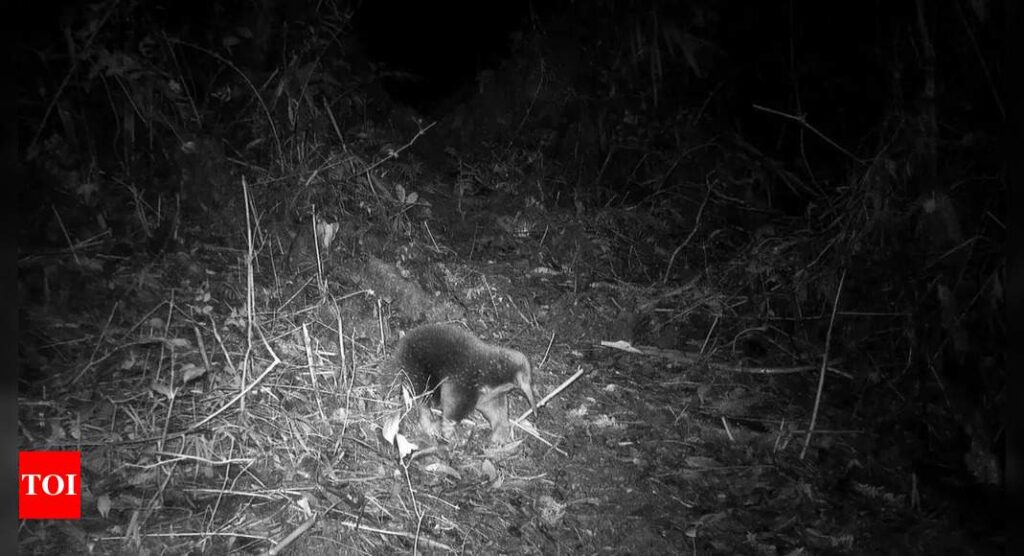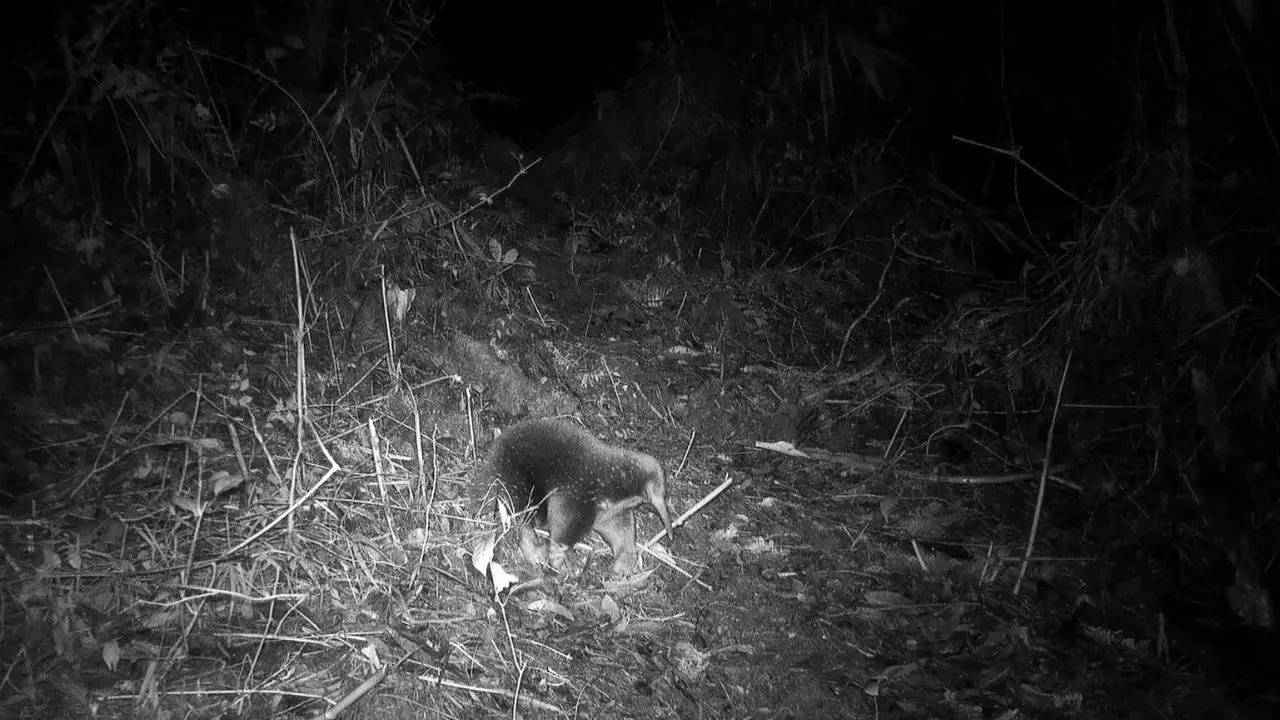[ad_1]
NEW DELHi: An egg-laying mammal, Attenborough’s long-beaked echidna, named after Sir David Attenborough, which was presumed to be extinct, was spotted in Indonesia using camera traps in the Cyclops Mountains of Papua Province.
According to The Independent, the unique mammal was last seen by scientists in 1961. It belongs to an exclusive category of egg-laying mammals known as monotremes that includes the platypus and is one of only five remaining species of such animals.
Echidnas are challenging to locate because of their nocturnal behavior and shy nature.Over 80 camera traps, deployed by an international team of researchers, collaborated with local communities that spent four weeks in the forest and recorded no sign of the mammal.
But, thankfully, on the final day of their expedition, the last images on the final memory card obtained the shots of the elusive animal, marking the first ever images taken of Attenborough’s echidna.
Mammalogist Kristofer Helgen from the Australian Museum Research Institute confirmed the species’ identification as Attenborough’s long-beaked echidna.
Dr Kempton, a biologist from Oxford University who led the expedition, said, “Attenborough’s long-beaked echidna has the spines of a hedgehog, the snout of an anteater, and the feet of a mole. Because of its hybrid appearance, it shares its name with a creature of Greek mythology that is half human, half serpent.”
“The reason it appears so unlike other mammals is because it is a member of the monotremes, an egg-laying group that separated from the rest of the mammal tree-of-life about 200 million years ago,” Dr Kempton added.
The team also discovered some other previously unknown species, which include beetles, spiders, scorpions, a new genus of tree-dwelling shrimp, and Mayr’s honeyeater, a bird presumed lost in scientific records since 2008.
“We were quite shocked to discover this shrimp in the heart of the forest, because it is a remarkable departure from the typical seaside habitat for these animals,” entomologist Leonidas-Romanos Davranoglou said.
“We believe that the high level of rainfall in the Cyclops Mountains means the humidity is great enough for these creatures to live entirely on land,” Dr Davranoglou added.
Despite challenging conditions, including venomous animals, blood-sucking leeches, malaria, earthquakes, and extreme heat in the region, the team also found a previously unknown cave system.
Scientists said that during the project, injuries and health challenges occurred, such as Dr Davranoglou breaking his arm, a team member contracting malaria, and another enduring a leech attached to his eye for a day and a half before it was finally removed.
Dr. James Kempton, leading the month-long expedition, told BBC News that, “I was euphoric, the whole team was euphoric,” the moment we spotted the Attenborough echidna in the camera trap footage.
“I’m not joking when I say it came down to the very last SD card that we looked at, from the very last camera that we collected, on the very last day of our expedition,” He added as per the BBC News.
Dr Kempton said, “Though some might describe the Cyclops as a ‘Green Hell’, I think the landscape is magical, at once enchanting and dangerous, like something out of a Tolkien book,” The Independent reported.
(With input from agencies)
According to The Independent, the unique mammal was last seen by scientists in 1961. It belongs to an exclusive category of egg-laying mammals known as monotremes that includes the platypus and is one of only five remaining species of such animals.
Echidnas are challenging to locate because of their nocturnal behavior and shy nature.Over 80 camera traps, deployed by an international team of researchers, collaborated with local communities that spent four weeks in the forest and recorded no sign of the mammal.
But, thankfully, on the final day of their expedition, the last images on the final memory card obtained the shots of the elusive animal, marking the first ever images taken of Attenborough’s echidna.
Mammalogist Kristofer Helgen from the Australian Museum Research Institute confirmed the species’ identification as Attenborough’s long-beaked echidna.
Dr Kempton, a biologist from Oxford University who led the expedition, said, “Attenborough’s long-beaked echidna has the spines of a hedgehog, the snout of an anteater, and the feet of a mole. Because of its hybrid appearance, it shares its name with a creature of Greek mythology that is half human, half serpent.”
“The reason it appears so unlike other mammals is because it is a member of the monotremes, an egg-laying group that separated from the rest of the mammal tree-of-life about 200 million years ago,” Dr Kempton added.
The team also discovered some other previously unknown species, which include beetles, spiders, scorpions, a new genus of tree-dwelling shrimp, and Mayr’s honeyeater, a bird presumed lost in scientific records since 2008.
“We were quite shocked to discover this shrimp in the heart of the forest, because it is a remarkable departure from the typical seaside habitat for these animals,” entomologist Leonidas-Romanos Davranoglou said.
“We believe that the high level of rainfall in the Cyclops Mountains means the humidity is great enough for these creatures to live entirely on land,” Dr Davranoglou added.
Despite challenging conditions, including venomous animals, blood-sucking leeches, malaria, earthquakes, and extreme heat in the region, the team also found a previously unknown cave system.
Scientists said that during the project, injuries and health challenges occurred, such as Dr Davranoglou breaking his arm, a team member contracting malaria, and another enduring a leech attached to his eye for a day and a half before it was finally removed.
Dr. James Kempton, leading the month-long expedition, told BBC News that, “I was euphoric, the whole team was euphoric,” the moment we spotted the Attenborough echidna in the camera trap footage.
“I’m not joking when I say it came down to the very last SD card that we looked at, from the very last camera that we collected, on the very last day of our expedition,” He added as per the BBC News.
Dr Kempton said, “Though some might describe the Cyclops as a ‘Green Hell’, I think the landscape is magical, at once enchanting and dangerous, like something out of a Tolkien book,” The Independent reported.
(With input from agencies)
[ad_2]
Source link











More Stories
We can’t wait to face India in the final: Pat Cummins | Cricket News
Railways plans 3,000 additional trains in next 4-5 years to minimise number of waitlisted tickets | India News
Faridabad: Man dies after ‘falling from hotel room window’ while partying with friends